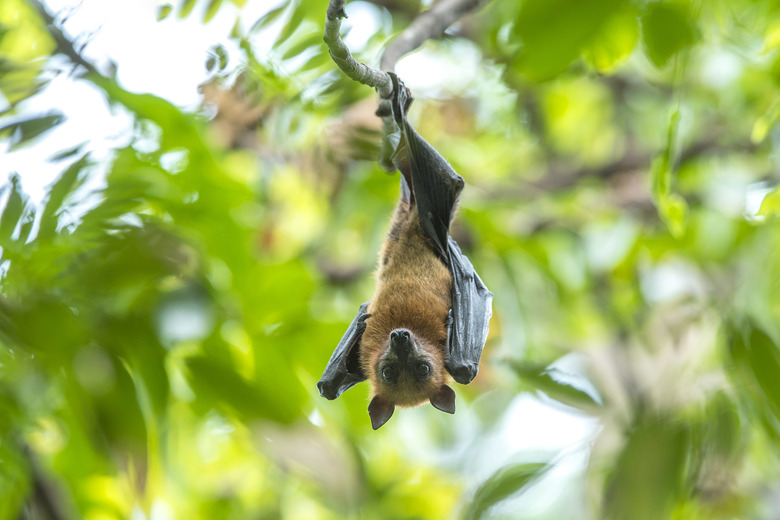Why We Can't Afford To Lose Bats
Bats suffer a public perception problem. Long villainized by Western cultures, much of the general public associates bats with Halloween, graveyards and the alter-ego of a certain blood-thirsty Transylvanian Count. Contrary to popular opinion, they're neither nefarious flying rodents, nor intent on infecting you with scary, lethal diseases.
In truth, bats are long-lived, intelligent and harmless mammals, whose behind-the-scenes contributions to human economies and ecosystems have long gone unnoticed. But new threats from a fungus and the blowing winds of renewable energy jeopardize not only their continued existence, but also billions of dollars in bat-related benefits.
The Human Benefits of Bats
The Human Benefits of Bats
Bats' association with vampires is somewhat ironic given that only three of the more than 1,200 known species consume blood and all live in Latin America, not Transylvania. Most bats feed on insects, fruit or nectar. In 2011, Boston University bat specialist Thomas Kunz and his co-authors published a study quantifying the significant, but often under-appreciated, ecological and economic benefits provided by bats.
Insect-eating bats, which account for 70 percent of all bat species, can consume two-thirds of their body weight in insects every night, including pests that can decimate crops and transmit disease to humans and animals. In just one year, one million bats consume the equivalent of 694 tons of insects.
In tropical regions, fruit- and nectar-eating bats play an essential role in dispersing seeds and pollen. Bats are critically important pollinators of the native agave used to produce tequila and mescal, multi-million dollar industries in Mexico. Other cash crops serviced by bats include mangoes, bananas, figs, papayas, avocados, shea butter, and a host of ornamental and timber species.
Bat excrement – guano – has been mined for fertilizer and supplies essential nutrients to cave-dwelling fish and endangered salamanders. Bats also provide cultural and aesthetic values. Bat watching at the Congress Avenue Bridge colony, home to 1.5 million Brazilian free-tailed bats, generates over $3 million in direct economic benefit to the city of Austin, Texas annually.
The Bat Apocalypse
The Bat Apocalypse
Globally, habitat degradation and the bush meat trade have diminished populations of many fruit- and nectar-eating bats. In North America, the future of many insectivorious bat species hangs in the balance because of unprecedented mortalities arising from the previously-unknown threats of white-nose syndrome and wind energy development.
White-nose syndrome first appeared in North American bats in 2006 and has since swept across 31 states and five Canadian provinces, primarily in the east and Midwest, with recent cases in Washington state. In less than a decade, it's killed more than 5.7 million bats, a death rate described by scientists as "the most precipitous decline of North American wildlife in recorded history."
As the name suggests, bats infected with the extraordinarily virulent, cold-loving fungus – Pseudogymnoascus destructans – develop a fuzzy white growth around their muzzles and wings. Besides destroying wing membranes and tissues, it prevents bats from fully hibernating, causing them to lose necessary winter fat reserves and effectively starve to death. Infected colonies have seen mortality in excess of 90 percent.
"So far we've not been able to slow its spread," said Dan Taylor, a biologist with Bat Conservation International. "However, we now know a lot more about the life cycle of the fungus, and there have been several promising studies indicating that certain naturally-occurring bacteria found on the skin of bats and in soil can inhibit its growth."
If the pathogen's spread is not stopped many species will be extinct within 20 years, the little brown bat among these. Once North America's most common bat with numbers in the millions, little brown bat populations have fallen by more than 75 percent. Besides being one of the Earth's longest-living mammals for its size, with a lifespan up to 35 years, the little brown bat is a voracious feeder that can consume nearly its body weight in insects each night.
Simultaneously, several migratory tree bat species have been affected by wind energy developments. Between 2000 and 2011, as many as 1.3 million bats died from collisions with the wind turbines or from barotrauma, the internal injuries resulting from rapid pressure changes near the blades.
Since early 2000, Bat Conservation International and others have been working with industry to develop strategies to reduce or eliminate the number of bats killed at wind farms. Increasing the wind turbine cut-in speed – the wind speed at which the blades begin turning – has been shown to reduce mortality by more than 50 percent. Turbine-mounted devices that produce ultrasonic sound waves may also reduce fatalities by deterring bats from sound sources.
In 2008, Kunz co-authored a study attempting to quantify the economic consequences of these combined losses. The researchers estimated the loss of bats to North American agriculture could fall in the range of $3.7 billion to $53 billion dollars per year.
A Public Relations Boost
A Public Relations Boost
Utilitarian value aside, Taylor inevitably gets questions about rabies.
"While bats can transit rabies, it's extremely rare," he said.
According to the Centers for Disease Control, between 1997 and 2006 only 17 human rabies cases in the U.S. were associated with bats. For context, each year an average of 20 people are killed by cattle.
Whether it's the threat of a lot more mosquitoes or the loss of margaritas and avocado toast, people's perception of bats is changing for the better, according to Taylor. For the sake of bats, and humans, that appreciation needs to follow with additional funding for research and conservation.
Cite This Article
MLA
Cozzens, Barbara. "Why We Can't Afford To Lose Bats" sciencing.com, https://www.sciencing.com/why-we-cant-afford-to-lose-bats-13400300/. 11 July 2017.
APA
Cozzens, Barbara. (2017, July 11). Why We Can't Afford To Lose Bats. sciencing.com. Retrieved from https://www.sciencing.com/why-we-cant-afford-to-lose-bats-13400300/
Chicago
Cozzens, Barbara. Why We Can't Afford To Lose Bats last modified March 24, 2022. https://www.sciencing.com/why-we-cant-afford-to-lose-bats-13400300/
